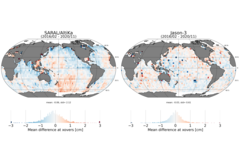News
05.03.2021 09:51 Age: 3 yrs
Jason-3 and SARAL/AltiKa 2020 annual reports
Category: Website updates

The 2020 annual reports of Jason-3 and SARAL/AltiKa are available on AVISO+. Several parameters are monitored including comparisons between missions.

Map of mean of SSH crossovers differences for [left] SARAL/AltiKa GDR-F and [right] Jason-3 GDR-D. Credits Cnes/CLS.
The Calibration and Validation activities performed on altimeter missions Jason-3 and SARAL/AltiKa ensure a high level quality of measurements delivered to users. Several parameters are monitored including comparisons between missions. Moreover, this year, a special attention has been paid to the SARAL/AltiKa GDR-F version.
Focus on SARAL/AltiKa conclusions
- SARAL/AltiKa provides an excellent coverage of the ocean, with more than 99% of measurements available over ocean.
- The global bias is of 45 mm with respect to Jason-3 and of 72 mm with respect to Jason-2.
- SLA statistics show no long term drifts, SARAL/AltiKa, Jason-2 and Jason-3 observe very similar SLA features when considering temporal evolution of global averages and also geographical patterns.
- Standard deviation of daily SLA averages differences between SARAL/AltiKa and both Jasons is below 5 mm.
- At crossovers SARAL/AltiKa shows a performance similar to Jason-2 with a standard deviation of 5.2 cm. Data quality remains excellent, even when considering the various mispointing events due to attitude deviations since SSA (Feb'2019). Only 5.38% of rejected measurements (locally up to 12% e.g. over Indian Ocean) during the editing process (once ice excluded), which is only slightly higher than Jason-2 (3.27%) and Jason-3 (3.24%).
Focus on Jason-3 conclusions
- Ocean data availability is excellent and similar between Jason-3 and Jason-2 with a percentage greater than 99.9% after removing specific events.
- Data quality is also very good with only 3.24% of measurements not consistent with altimeter and radiometer parameters threshold criterion. Jason-2 presents an equivalent percentage of edited data.
- The altimetry parameters analysis highlights a similar behaviour compared to Jason-2. Some biases exist as between dual-frequency ionosphere correction, but they are stable.
- At crossovers, Jason-3 shows performance similar to Jason-2 with a standard deviation lower than 5 cm. However mean difference analysis highlights a 120-days signal, which is present for both missions and could be further reduced by alternative orbit solutions.
- At crossovers between Jason-3 and Jason-2, SSH performance presents excellent results with an SLA biais of about 3 cm. The consistency between both SLA is good with a small geographically correlated signal (lower than 0.5 cm in GDR) due to orbit quality.
See Jason-3 and SARAL/AltiKa detailed information.




